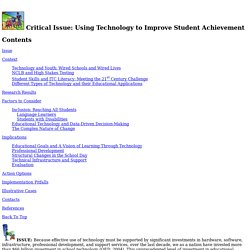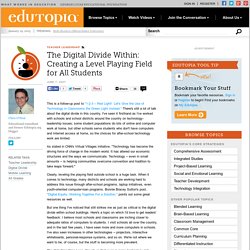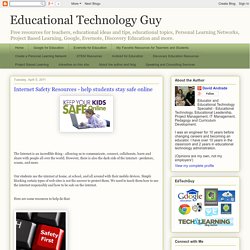

Using Technology to Improve Student Achievement. Critical Issue: Using Technology to Improve Student Achievement Contents Issue Context Research Results Factors to Consider.

The Digital Divide Within: Creating a Level Playing Field for All Students. This is a follow-up post to "1-2-3 -- Red Light!

: Let's Give the Use of Technology in Classrooms the Green Light Instead. " There's still a lot of talk about the digital divide in this country. I've seen it firsthand as I've worked with schools and school districts around the country on technology-leadership issues; some student populations do lots of online and computer work at home, but other schools serve students who don't have computers and Internet access at home, so the choices for after-school technology work are limited. As stated in CNN's Virtual Villages initiative, "Technology has become the driving force of change in the modern world. It has altered our economic structures and the ways we communicate. Internet Safety Resources - help students stay safe online.
The Internet is an incredible thing - allowing us to communicate, connect, collaborate, learn and share with people all over the world.

However, there is also the dark side of the internet - predators, scams, and more.Our students use the internet at home, at school, and all around with their mobile devices. Simply blocking certain types of web sites is not the answer to protect them. Copyright Fair Use and How it Works for Online Images. You’ve heard the adage that a picture is worth a thousand words, but when that picture is protected by copyright, the picture is only worth three words: cease and desist.

OK, that’s kind of a lawyer joke. But it illustrates how protective people are about finding their images used online without permission. Copyright laws were established not to give the author the right to deny their work to other people, but instead to encourage its creation. Article I, Section 8, clause 8, of the United States Constitution states the purpose of copyright laws is “to promote the Progress of Science and useful Arts, by securing for limited times to Authors and Inventors the exclusive Right to their respective Writings and Discoveries.”
It’s a delicate balance between the rights of the creator and the public’s interest. Developing and Validating a Media Literacy Self-Evaluation Scale (MLSS) for Elementary School Students. Problems Related To Computer Ethics: Origins Of The Problems And Suggested Solutions. Developing a scale for teacher integration of information and communication...: OneSearch.